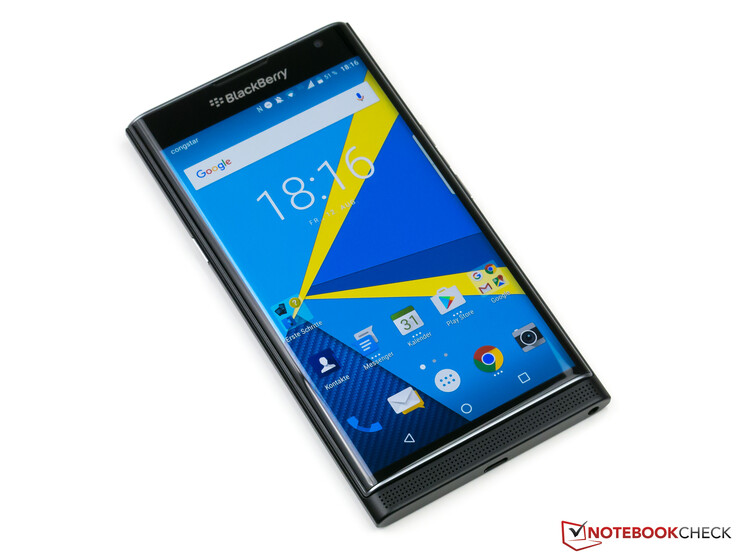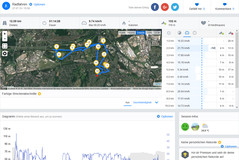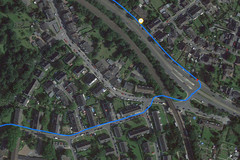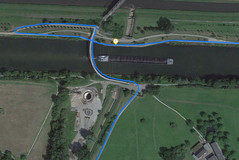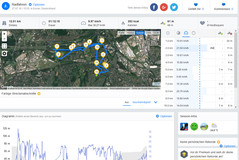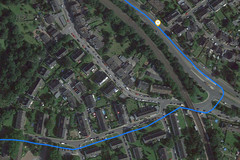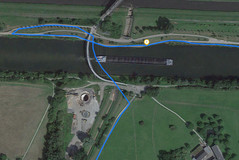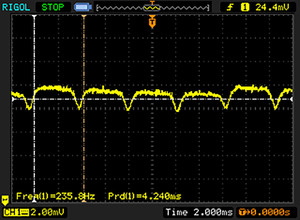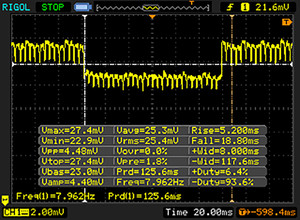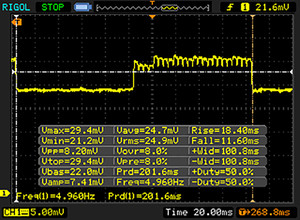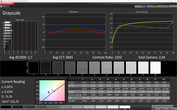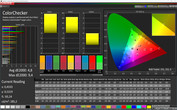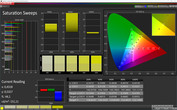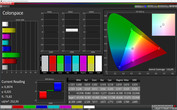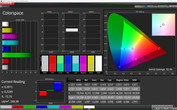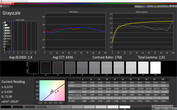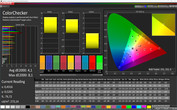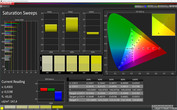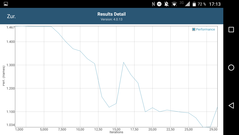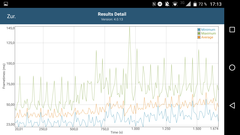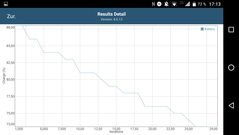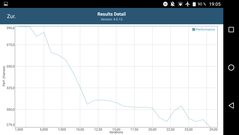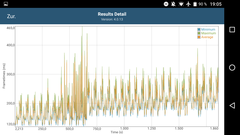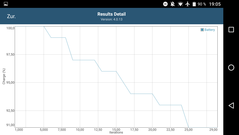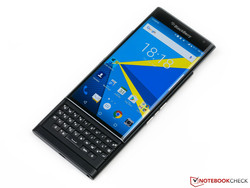Breve Análise do Smartphone BlackBerry Priv
Os Top 10
» Os Top 10 Portáteis Multimídia
» Os Top 10 Portáteis de Jogos
» Os Top 10 Portáteis Leves para Jogos
» Os Top 10 Portáteis Acessíveis de Escritório/Empresariais
» Os Top 10 Portáteis Premium de Escritório/Empresariais
» Os Top 10 dos Portáteis Workstation
» Os Top 10 Subportáteis
» Os Top 10 Ultrabooks
» Os Top 10 Conversíveis
» Os Top 10 Tablets
» Os Top 10 Smartphones
» A melhores Telas de Portáteis Analisadas Pela Notebookcheck
» Top 10 dos portáteis abaixo dos 500 Euros da Notebookcheck
» Top 10 dos Portáteis abaixo dos 300 Euros
Size Comparison
| Networking | |
| iperf Server (receive) TCP 1 m | |
| BlackBerry Priv | |
| LG G5 | |
| Samsung Galaxy S7 Edge | |
| Huawei P9 | |
| Sony Xperia XA | |
| Honor 5C | |
| iperf Client (transmit) TCP 1 m | |
| Samsung Galaxy S7 Edge | |
| BlackBerry Priv | |
| Huawei P9 | |
| LG G5 | |
| Sony Xperia XA | |
| Honor 5C | |
| |||||||||||||||||||||||||
iluminação: 70 %
iluminação com acumulador: 327 cd/m²
Contraste: ∞:1 (Preto: 0 cd/m²)
ΔE ColorChecker Calman: 4.1 | ∀{0.5-29.43 Ø4.78}
ΔE Greyscale Calman: 2.4 | ∀{0.09-98 Ø5}
Gamma: 2.01
CCT: 6436 K
| BlackBerry Priv AMOLED, 2560x1440, 5.4" | Samsung Galaxy S7 Edge Super AMOLED, 2560x1440, 5.5" | LG G5 IPS Quantum, 2560x1440, 5.3" | Huawei P9 Plus AMOLED, 1920x1080, 5.5" | Google Nexus 5X IPS, 1920x1080, 5.2" | Microsoft Lumia 950 XL AMOLED, 2560x1440, 5.7" | Apple iPhone 6S Plus IPS, 1920x1080, 5.5" | |
|---|---|---|---|---|---|---|---|
| Screen | 51% | -9% | -24% | 38% | 13% | 23% | |
| Brightness middle (cd/m²) | 327 | 554 69% | 784 140% | 361 10% | 503 54% | 297 -9% | 583 78% |
| Brightness (cd/m²) | 363 | 552 52% | 774 113% | 366 1% | 498 37% | 297 -18% | 560 54% |
| Brightness Distribution (%) | 70 | 96 37% | 91 30% | 87 24% | 97 39% | 93 33% | 91 30% |
| Black Level * (cd/m²) | 0.43 | 0.38 | 0.46 | ||||
| Colorchecker dE 2000 * | 4.1 | 1.59 61% | 6.5 -59% | 5.1 -24% | 2.09 49% | 2.67 35% | 3.55 13% |
| Colorchecker dE 2000 max. * | 8.1 | 2.56 68% | 11.7 -44% | 10 -23% | 3.98 51% | ||
| Greyscale dE 2000 * | 2.4 | 2.01 16% | 8 -233% | 5.5 -129% | 2.12 12% | 2.81 -17% | 3.88 -62% |
| Gamma | 2.01 109% | 2.01 109% | 2.22 99% | 2.24 98% | 2.27 97% | 2.08 106% | 2.2 100% |
| CCT | 6436 101% | 6321 103% | 8699 75% | 7388 88% | 6621 98% | 6379 102% | 7280 89% |
| Color Space (Percent of AdobeRGB 1998) (%) | 82.12 | 68.08 | 66.31 | 59.05 | |||
| Color Space (Percent of sRGB) (%) | 99.98 | 97.46 | 99.79 | 92.8 | |||
| Contrast (:1) | 1823 | 1324 | 1267 |
* ... menor é melhor
Cintilação da tela / PWM (modulação por largura de pulso)
| Tela tremeluzindo/PWM detectado | 235.8 Hz | ≤ 100 % configuração de brilho | |
A luz de fundo da tela pisca em 235.8 Hz (pior caso, por exemplo, utilizando PWM) Cintilação detectada em uma configuração de brilho de 100 % e abaixo. Não deve haver cintilação ou PWM acima desta configuração de brilho. A frequência de 235.8 Hz é relativamente baixa, portanto, usuários sensíveis provavelmente notarão cintilação e sentirão fadiga ocular na configuração de brilho indicada e abaixo. [pwm_comparison] Em comparação: 53 % de todos os dispositivos testados não usam PWM para escurecer a tela. Se PWM foi detectado, uma média de 8118 (mínimo: 5 - máximo: 343500) Hz foi medida. | |||
Exibir tempos de resposta
| ↔ Tempo de resposta preto para branco | ||
|---|---|---|
| 24 ms ... ascensão ↗ e queda ↘ combinadas | ↗ 5.2 ms ascensão | |
| ↘ 18.8 ms queda | ||
| A tela mostra boas taxas de resposta em nossos testes, mas pode ser muito lenta para jogadores competitivos. Em comparação, todos os dispositivos testados variam de 0.1 (mínimo) a 240 (máximo) ms. » 53 % de todos os dispositivos são melhores. Isso significa que o tempo de resposta medido é pior que a média de todos os dispositivos testados (20.2 ms). | ||
| ↔ Tempo de resposta 50% cinza a 80% cinza | ||
| 30 ms ... ascensão ↗ e queda ↘ combinadas | ↗ 18.4 ms ascensão | |
| ↘ 11.6 ms queda | ||
| A tela mostra taxas de resposta lentas em nossos testes e será insatisfatória para os jogadores. Em comparação, todos os dispositivos testados variam de 0.165 (mínimo) a 636 (máximo) ms. » 39 % de todos os dispositivos são melhores. Isso significa que o tempo de resposta medido é semelhante à média de todos os dispositivos testados (31.6 ms). | ||
| Geekbench 3 | |
| 64 Bit Multi-Core Score (classificar por valor) | |
| BlackBerry Priv | |
| Samsung Galaxy S7 Edge | |
| LG G5 | |
| Huawei P9 Plus | |
| Google Nexus 5X | |
| Apple iPhone 6S Plus | |
| 64 Bit Single-Core Score (classificar por valor) | |
| BlackBerry Priv | |
| Samsung Galaxy S7 Edge | |
| LG G5 | |
| Huawei P9 Plus | |
| Google Nexus 5X | |
| Apple iPhone 6S Plus | |
| AnTuTu v6 - Total Score (classificar por valor) | |
| BlackBerry Priv | |
| Samsung Galaxy S7 Edge | |
| LG G5 | |
| Huawei P9 Plus | |
| Microsoft Lumia 950 XL | |
| Apple iPhone 6S Plus | |
| PCMark for Android - Work performance score (classificar por valor) | |
| BlackBerry Priv | |
| Samsung Galaxy S7 Edge | |
| LG G5 | |
| Huawei P9 Plus | |
| Google Nexus 5X | |
| GFXBench (DX / GLBenchmark) 2.7 | |
| T-Rex Onscreen (classificar por valor) | |
| BlackBerry Priv | |
| Samsung Galaxy S7 Edge | |
| LG G5 | |
| Huawei P9 Plus | |
| Google Nexus 5X | |
| Microsoft Lumia 950 XL | |
| Apple iPhone 6S Plus | |
| 1920x1080 T-Rex Offscreen (classificar por valor) | |
| BlackBerry Priv | |
| Samsung Galaxy S7 Edge | |
| LG G5 | |
| Huawei P9 Plus | |
| Google Nexus 5X | |
| Microsoft Lumia 950 XL | |
| Apple iPhone 6S Plus | |
| GFXBench 3.0 | |
| 1920x1080 1080p Manhattan Offscreen (classificar por valor) | |
| BlackBerry Priv | |
| Samsung Galaxy S7 Edge | |
| LG G5 | |
| Huawei P9 Plus | |
| Google Nexus 5X | |
| Microsoft Lumia 950 XL | |
| Apple iPhone 6S Plus | |
| on screen Manhattan Onscreen OGL (classificar por valor) | |
| BlackBerry Priv | |
| Samsung Galaxy S7 Edge | |
| LG G5 | |
| Huawei P9 Plus | |
| Google Nexus 5X | |
| Microsoft Lumia 950 XL | |
| Apple iPhone 6S Plus | |
| GFXBench 3.1 | |
| 1920x1080 Manhattan ES 3.1 Offscreen (classificar por valor) | |
| BlackBerry Priv | |
| Samsung Galaxy S7 Edge | |
| LG G5 | |
| Huawei P9 Plus | |
| Apple iPhone 6S Plus | |
| on screen Manhattan ES 3.1 Onscreen (classificar por valor) | |
| BlackBerry Priv | |
| Samsung Galaxy S7 Edge | |
| LG G5 | |
| Huawei P9 Plus | |
| Apple iPhone 6S Plus | |
| GFXBench | |
| 1920x1080 Car Chase Offscreen (classificar por valor) | |
| BlackBerry Priv | |
| Samsung Galaxy S7 Edge | |
| LG G5 | |
| Huawei P9 Plus | |
| on screen Car Chase Onscreen (classificar por valor) | |
| BlackBerry Priv | |
| Samsung Galaxy S7 Edge | |
| LG G5 | |
| Huawei P9 Plus | |
| 3DMark | |
| 1280x720 offscreen Ice Storm Unlimited Score (classificar por valor) | |
| BlackBerry Priv | |
| Samsung Galaxy S7 Edge | |
| LG G5 | |
| Huawei P9 Plus | |
| Google Nexus 5X | |
| Apple iPhone 6S Plus | |
| 1280x720 offscreen Ice Storm Unlimited Graphics Score (classificar por valor) | |
| BlackBerry Priv | |
| Samsung Galaxy S7 Edge | |
| LG G5 | |
| Huawei P9 Plus | |
| Google Nexus 5X | |
| Apple iPhone 6S Plus | |
| 1280x720 offscreen Ice Storm Unlimited Physics (classificar por valor) | |
| BlackBerry Priv | |
| Samsung Galaxy S7 Edge | |
| LG G5 | |
| Huawei P9 Plus | |
| Google Nexus 5X | |
| Apple iPhone 6S Plus | |
| 2560x1440 Sling Shot OpenGL ES 3.0 Physics (classificar por valor) | |
| BlackBerry Priv | |
| Samsung Galaxy S7 Edge | |
| LG G5 | |
| Huawei P9 Plus | |
| Google Nexus 5X | |
| Apple iPhone 6S Plus | |
| 2560x1440 Sling Shot OpenGL ES 3.0 Graphics (classificar por valor) | |
| BlackBerry Priv | |
| Samsung Galaxy S7 Edge | |
| LG G5 | |
| Huawei P9 Plus | |
| Google Nexus 5X | |
| Apple iPhone 6S Plus | |
| 2560x1440 Sling Shot OpenGL ES 3.0 (classificar por valor) | |
| BlackBerry Priv | |
| Samsung Galaxy S7 Edge | |
| LG G5 | |
| Huawei P9 Plus | |
| Google Nexus 5X | |
| Apple iPhone 6S Plus | |
| Mozilla Kraken 1.1 - Total (classificar por valor) | |
| BlackBerry Priv | |
| Samsung Galaxy S7 Edge | |
| LG G5 | |
| Huawei P9 Plus | |
| Google Nexus 5X | |
| Microsoft Lumia 950 XL | |
| Apple iPhone 6S Plus | |
| Octane V2 - Total Score (classificar por valor) | |
| BlackBerry Priv | |
| Samsung Galaxy S7 Edge | |
| LG G5 | |
| Huawei P9 Plus | |
| Google Nexus 5X | |
| Microsoft Lumia 950 XL | |
| Apple iPhone 6S Plus | |
| WebXPRT 2015 - Overall (classificar por valor) | |
| BlackBerry Priv | |
| Samsung Galaxy S7 Edge | |
| LG G5 | |
| Huawei P9 Plus | |
| Google Nexus 5X | |
| Microsoft Lumia 950 XL | |
| Apple iPhone 6S Plus | |
| JetStream 1.1 - Total Score (classificar por valor) | |
| BlackBerry Priv | |
| Samsung Galaxy S7 Edge | |
| LG G5 | |
| Huawei P9 Plus | |
| Google Nexus 5X | |
| Microsoft Lumia 950 XL | |
| Apple iPhone 6S Plus | |
* ... menor é melhor
| AndroBench 3-5 | |
| Random Read 4KB (classificar por valor) | |
| BlackBerry Priv | |
| Samsung Galaxy S7 Edge | |
| LG G5 | |
| Huawei P9 Plus | |
| Google Nexus 5X | |
| Random Write 4KB (classificar por valor) | |
| BlackBerry Priv | |
| Samsung Galaxy S7 Edge | |
| LG G5 | |
| Huawei P9 Plus | |
| Google Nexus 5X | |
| Sequential Write 256KB (classificar por valor) | |
| BlackBerry Priv | |
| Samsung Galaxy S7 Edge | |
| LG G5 | |
| Huawei P9 Plus | |
| Google Nexus 5X | |
| Sequential Read 256KB (classificar por valor) | |
| BlackBerry Priv | |
| Samsung Galaxy S7 Edge | |
| LG G5 | |
| Huawei P9 Plus | |
| Google Nexus 5X | |
| Sequential Write 256KB SDCard (classificar por valor) | |
| BlackBerry Priv | |
| Samsung Galaxy S7 Edge | |
| LG G5 | |
| Huawei P9 Plus | |
| Sequential Read 256KB SDCard (classificar por valor) | |
| BlackBerry Priv | |
| Samsung Galaxy S7 Edge | |
| LG G5 | |
| Huawei P9 Plus | |
| BaseMark OS II - Memory (classificar por valor) | |
| BlackBerry Priv | |
| Samsung Galaxy S7 Edge | |
| LG G5 | |
| Huawei P9 Plus | |
| Google Nexus 5X | |
| Microsoft Lumia 950 XL | |
| Apple iPhone 6S Plus | |
| Asphalt 8: Airborne | |||
| Configurações | Valor | ||
| high | 24 fps | ||
| very low | 28 fps | ||
| Dead Trigger 2 | |||
| Configurações | Valor | ||
| high | 47 fps | ||
(±) A temperatura máxima no lado superior é 41.4 °C / 107 F, em comparação com a média de 35.2 °C / 95 F , variando de 21.9 a 247 °C para a classe Smartphone.
(-) A parte inferior aquece até um máximo de 47.4 °C / 117 F, em comparação com a média de 34 °C / 93 F
(±) Em uso inativo, a temperatura média para o lado superior é 36.5 °C / 98 F, em comparação com a média do dispositivo de 32.9 °C / ### class_avg_f### F.
BlackBerry Priv análise de áudio
(+) | os alto-falantes podem tocar relativamente alto (###valor### dB)
Graves 100 - 315Hz
(-) | quase nenhum baixo - em média 32.7% menor que a mediana
(±) | a linearidade dos graves é média (11.6% delta para a frequência anterior)
Médios 400 - 2.000 Hz
(+) | médios equilibrados - apenas 3.9% longe da mediana
(+) | médios são lineares (6.2% delta para frequência anterior)
Altos 2 - 16 kHz
(+) | agudos equilibrados - apenas 2.9% longe da mediana
(+) | os máximos são lineares (2.6% delta da frequência anterior)
Geral 100 - 16.000 Hz
(±) | a linearidade do som geral é média (21.3% diferença em relação à mediana)
Comparado com a mesma classe
» 40% de todos os dispositivos testados nesta classe foram melhores, 8% semelhantes, 52% piores
» O melhor teve um delta de 11%, a média foi 35%, o pior foi 134%
Comparado com todos os dispositivos testados
» 58% de todos os dispositivos testados foram melhores, 7% semelhantes, 34% piores
» O melhor teve um delta de 4%, a média foi 24%, o pior foi 134%
Samsung Galaxy S7 Edge análise de áudio
(+) | os alto-falantes podem tocar relativamente alto (###valor### dB)
Graves 100 - 315Hz
(-) | quase nenhum baixo - em média 27.4% menor que a mediana
(±) | a linearidade dos graves é média (8.7% delta para a frequência anterior)
Médios 400 - 2.000 Hz
(+) | médios equilibrados - apenas 4.4% longe da mediana
(+) | médios são lineares (4.7% delta para frequência anterior)
Altos 2 - 16 kHz
(±) | máximos mais altos - em média 5.8% maior que a mediana
(+) | os máximos são lineares (6.2% delta da frequência anterior)
Geral 100 - 16.000 Hz
(±) | a linearidade do som geral é média (20.6% diferença em relação à mediana)
Comparado com a mesma classe
» 35% de todos os dispositivos testados nesta classe foram melhores, 9% semelhantes, 56% piores
» O melhor teve um delta de 11%, a média foi 35%, o pior foi 134%
Comparado com todos os dispositivos testados
» 54% de todos os dispositivos testados foram melhores, 8% semelhantes, 38% piores
» O melhor teve um delta de 4%, a média foi 24%, o pior foi 134%
| desligado | |
| Ocioso | |
| Carga |
|
Key:
min: | |
| BlackBerry Priv 3410 mAh | Samsung Galaxy S7 Edge 3600 mAh | LG G5 2800 mAh | Huawei P9 Plus 3400 mAh | Google Nexus 5X mAh | Microsoft Lumia 950 XL 3340 mAh | Apple iPhone 6S Plus 2750 mAh | |
|---|---|---|---|---|---|---|---|
| Power Consumption | 17% | -1% | 20% | 10% | -99% | 9% | |
| Idle Minimum * (Watt) | 0.85 | 0.63 26% | 0.55 35% | 0.87 -2% | 0.55 35% | 2.85 -235% | 0.5 41% |
| Idle Average * (Watt) | 1.46 | 1.1 25% | 1.37 6% | 1.2 18% | 1.44 1% | 2.95 -102% | 1.9 -30% |
| Idle Maximum * (Watt) | 1.47 | 1.56 -6% | 2.25 -53% | 1.27 14% | 1.9 -29% | 3.26 -122% | 2.2 -50% |
| Load Average * (Watt) | 6.53 | 5.95 9% | 6.24 4% | 4.69 28% | 3.36 49% | 8.92 -37% | 3.2 51% |
| Load Maximum * (Watt) | 9.42 | 6.7 29% | 9.12 3% | 5.63 40% | 9.76 -4% | 9.39 -0% | 6.4 32% |
* ... menor é melhor
| BlackBerry Priv 3410 mAh | Samsung Galaxy S7 Edge 3600 mAh | LG G5 2800 mAh | Huawei P9 Plus 3400 mAh | Google Nexus 5X mAh | Microsoft Lumia 950 XL 3340 mAh | Apple iPhone 6S Plus 2750 mAh | |
|---|---|---|---|---|---|---|---|
| Duração da bateria | 41% | 2% | 10% | -1% | -20% | 5% | |
| Reader / Idle (h) | 22.8 | 27.7 21% | 30.6 34% | 24.1 6% | 29.6 30% | 18 -21% | 27.6 21% |
| H.264 (h) | 10.9 | 15.2 39% | 10 -8% | 12.9 18% | 9.3 -15% | 10.2 -6% | 11.9 9% |
| WiFi v1.3 (h) | 6.9 | 12.2 77% | 6.5 -6% | 8.8 28% | 6.9 0% | 6.2 -10% | 8.6 25% |
| Load (h) | 5.1 | 6.5 27% | 4.5 -12% | 4.4 -14% | 4.1 -20% | 3 -41% | 3.3 -35% |
Pro
Contra
O BlackBerry Priv não foi um sucesso para a empresa, apesar do sólido hardware: A tela táctil precisa, o material anti-deslizante da carcaça, e a tela de alta resolução agradam durante o uso cotidiano. As diversas modificações do software e da câmera principal também são práticas. Embora o desempenho do Snapdragon 808 dificilmente possa se comparar com a concorrência mais moderna, é suficiente para uma experiência fluida. O custo da construção relativamente fina, apesar do mecanismo deslizante é a a propensão a superaquecer. Além disso, o aparelho não oferece um leitor de digitais ou uma câmera frontal melhor para se nivelar com outros modelos premium.
As opiniões sobre o teclado físico provavelmente diferirão. Um usuário inexperiente dificilmente digitará mais rápido nele que em um teclado virtual e, portanto, o encontrará supérfluo. No entanto, é possível digitar nas teclas iluminadas sem olhar, depois de praticar um pouco, e elas são indiretamente responsáveis por mais espaço na tela, que pode então ser utilizado por outros conteúdos visuais.
A Blackberry não confia tanto em superlativos técnicos como em soluções inteligentes para o uso cotidiano em seu modelo premium, Priv.
Embora o modelo de teste não tenha oponentes diretos, devido a sua configuração especial com um teclado físico, alguns smartphones topo de linha que são evidentemente superiores ao Priv em alguns aspectos, como desempenho, existem na faixa de preços de 650 Euro (~$737). Aqui, sempre vale a penas dar uma olhada, especialmente no Samsung Galaxy S7 Edge.
BlackBerry Priv
- 08/19/2016 v5.1 (old)
Andreas Kilian




